Winter Steelhead Fishing On the Salmon River
The cure for cabin fever is in the waters of the Salmon River.
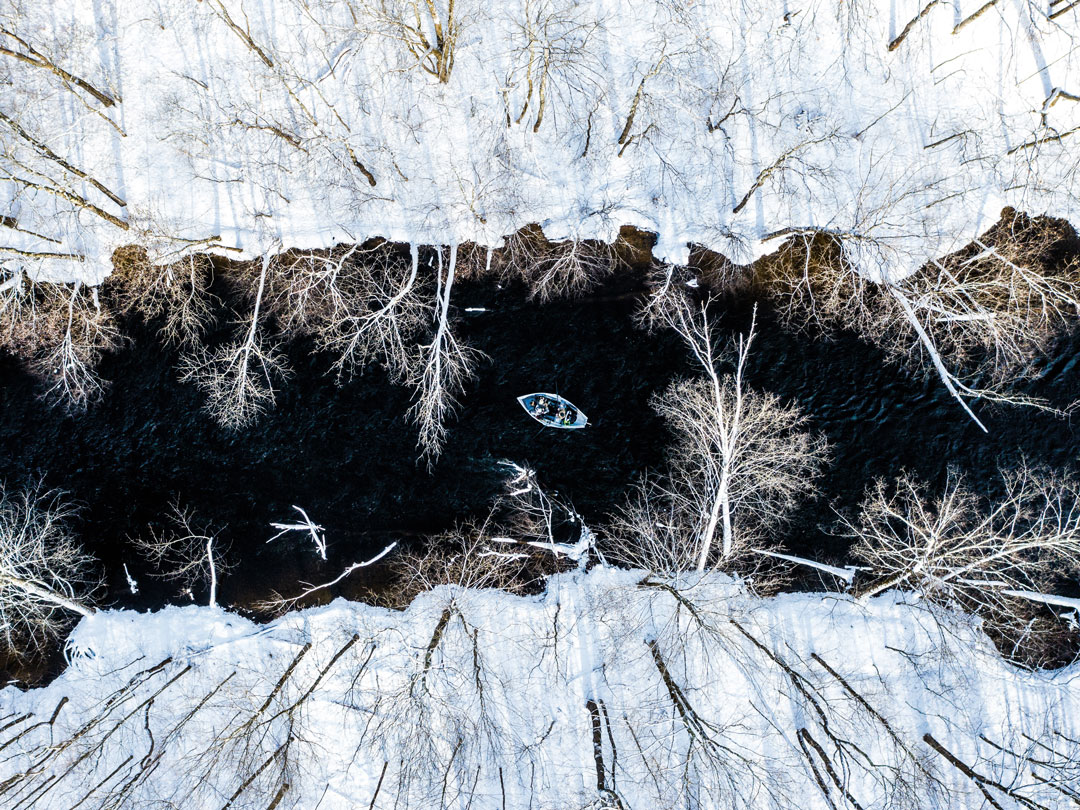
In their native range of the Pacific Northwest, a steelhead is a rainbow trout that, instead of living out its days in the river, migrates downstream to the ocean. There, it grows large and hard while evading sea lions, orcas, and nets, fattening up on crustaceans and baitfish. At some point, fisheries managers learned that steelhead strains of rainbow trout stocked in the tributaries of the Great Lakes would exhibit the same behavior, leaving the rivers to feed in the vast lakes for a few years before returning. This discovery brought the Northwest’s favorite gamefish within road-trip distance of striper-obsessed Northeast fishermen, helping them better survive the cold, striper-less winter months.
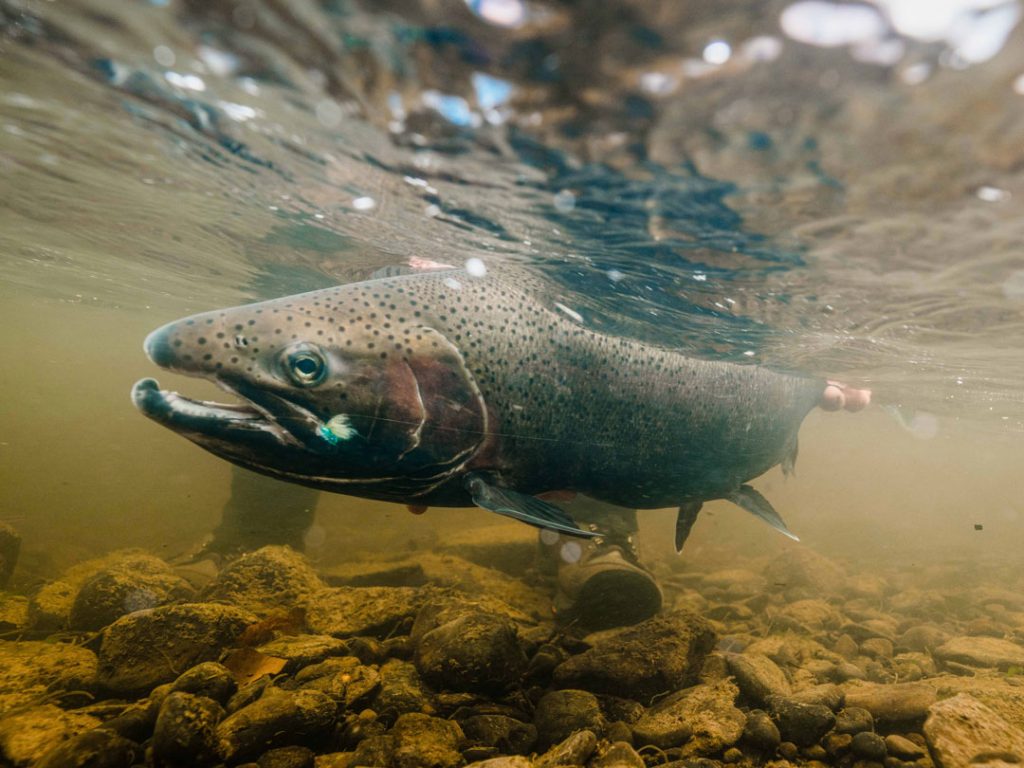
A hooked steelhead rivals a striped bass for strength, an albie for speed, and a bluefish for aerial acrobatics. The electric shock transmitted through the line by a running steelhead immediately and completely banishes cabin fever, cold, and any questions about why you’re wading in a 34-degree river in the depths of winter.
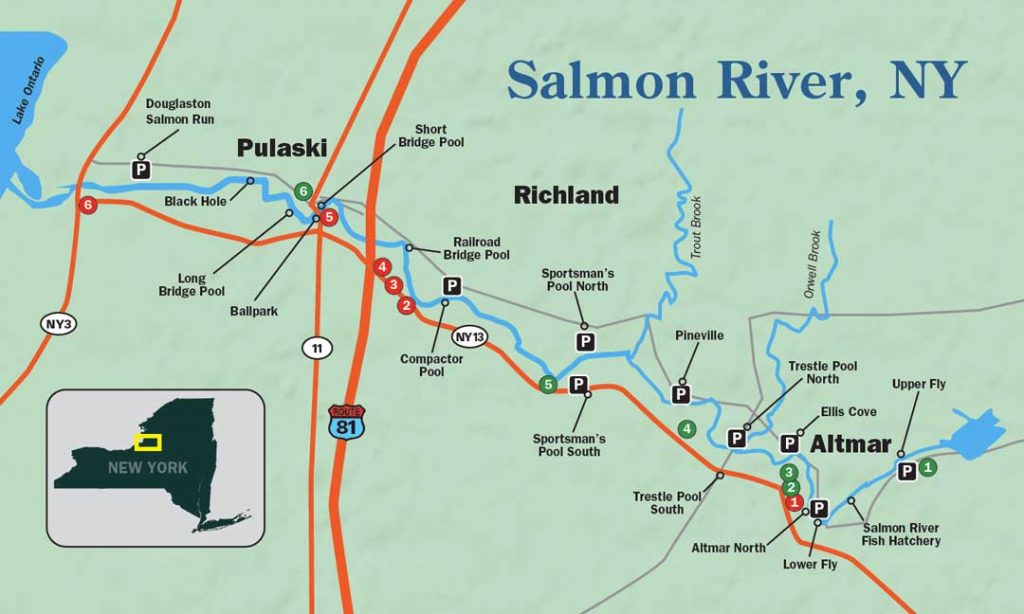
New York boasts nearly two dozen rivers and creeks with steelhead runs on both Lake Ontario and Lake Erie. While anglers all have their favorites, the river with the largest number of steelhead—and the largest number of steelhead anglers—is Oswego County’s Salmon River.
There are 13 miles of fishable water in the Salmon River, including the private stretch at Douglaston Salmon Run. Steelhead begin to enter the river in September, on the heels of spawning salmon, and they come and go from the river until they spawn in the spring. Surviving steelhead will hightail it back to the lake before mid-May for another season of feeding and growing.
The fall and spring legs of the steelhead season have more comfortable conditions, more active fish, and more anglers. The winter, however, rewards hearty anglers with lots of room to roam and plenty of shots at steelhead.
Finding Winter Steelhead
When water temperature drops and the salmon egg feast slows to a trickle, steelhead hunker down in deep, slow pools, where they can conserve energy and ride out the winter. As one of the most-fished rivers in the Northeast, the Salmon River’s most popular pools are well marked with signs (and on maps). Favorite winter spots include the Lower Fly Zone, Altmar, the Trestle Pool, and the Sportsman’s Pool, all of which are in what anglers consider the upper river.
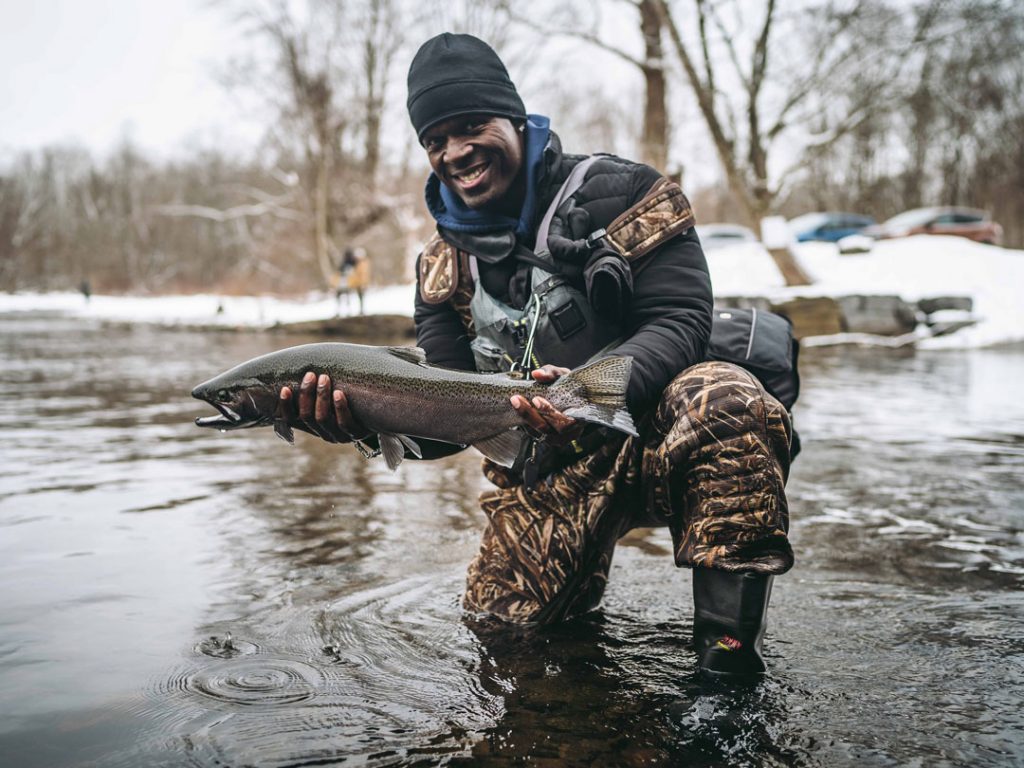
In general, most of the steelhead you’ll find in the winter have been in the river for weeks to months. The bright chrome coloration they carried in the lake darkens to better suit life in the river: a dull olive in the males and a tarnished silver in the females. Anytime there’s a boost in the water level, more steelhead enter the system from the lake, but once the snow hits the ground, expect the water to be low and clear for most of the winter.
This can create challenging fishing conditions, with steelhead being selective and spooky, but the silver lining is that more of the river is accessible to shore-bound anglers, who are sometimes boxed out of prime waters by higher water flows.
During the spring and fall, a better approach might be to keep moving on the hunt for active fish, but in the winter, steelhead stakeouts often yield better results.
Catching Winter Steelhead
There will be windows throughout the day when the steelhead, even ones that have seen your offering drift by multiple times, will feed. While it may feel monotonous, continuing to work a pool that you’re confident is holding fish will eventually yield results. Continue to change colors and presentations, and make sure your offering is drifting through the zone for those brief windows. That zone is the bottom.
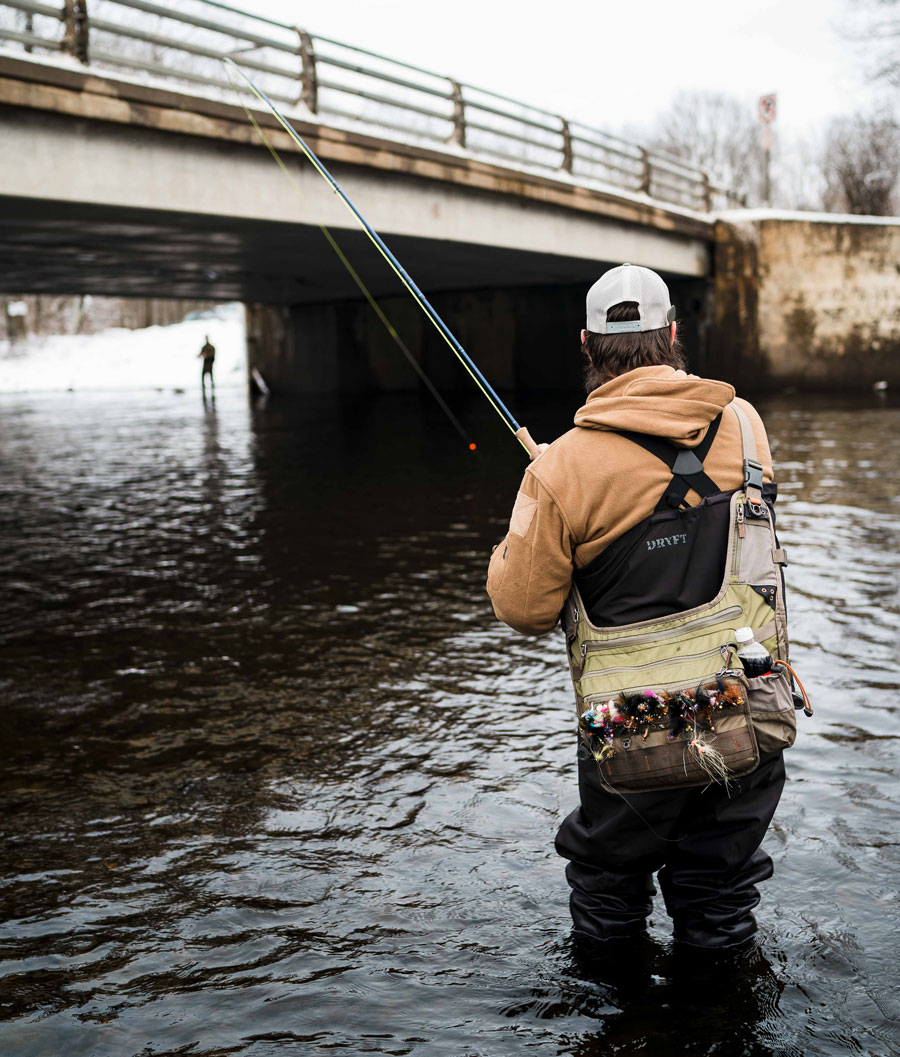
Steelhead spend the winter with their bellies to the gravel, so your offering needs to be within 6 inches of the river bottom. For fly fishing and bottom bouncing, this means finding a precise amount of split shot to add that keeps your presentation near the bottom without snagging. The needed weight changes based on water, location, and even what type of bait or fly you’re using. The ideal amount of split shot should have the rig touching bottom a couple times during the drift, but not dragging.
Pack a variety of removeable split-shot sizes to dial in the right amount of weight—and plenty of them. The Salmon River is a snaggy one, and if you aren’t losing a few rigs, then you aren’t fishing it right.
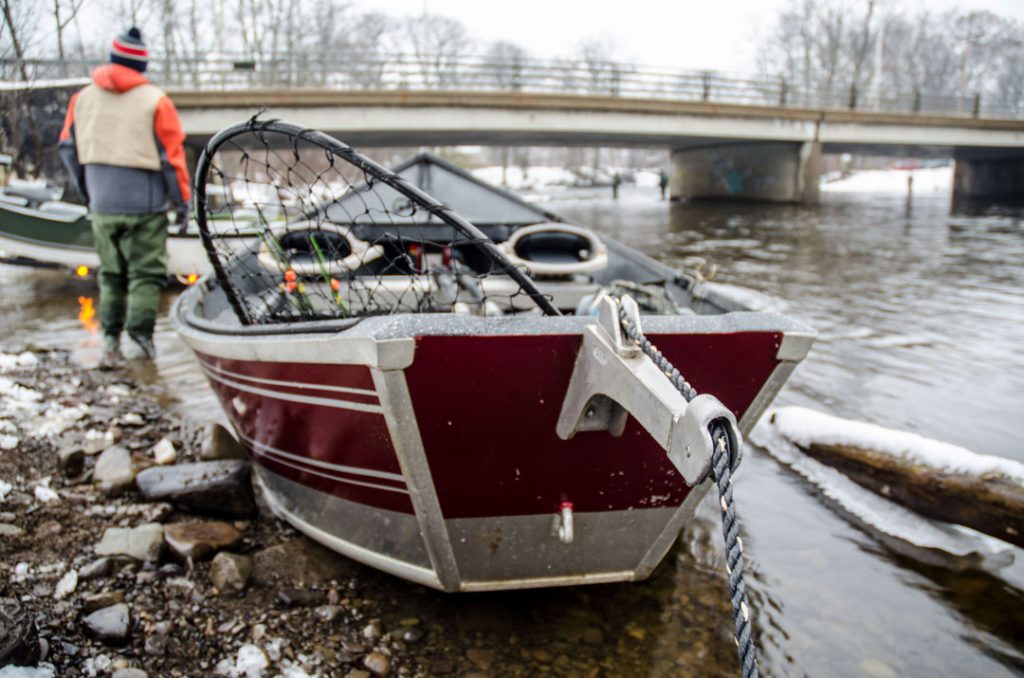
Float fishing is another approach to winter steelheading that requires more tackle and rigging, but can be more effective and results in fewer lost rigs. In float fishing, a specialized bobber above a series of split shots spaced between the bobber and the bait creates a drift that perfectly matches the speed of the current. When targeting steelhead in one of the most heavily fished rivers in the Northeast, having your offering appear as natural as possible is essential, and that’s what float fishing provides.
Float fishing is possible on spinning tackle with a long, limber rod, but it’s best accomplished with a centerpin reel—one that spins freely, feeding line to a drifting rig.
Baits and Flies for Winter Steelhead
Salmon and trout eggs are steelheads’ favorite food once they enter the Salmon River. Even though free-drifting eggs may be in short supply by the middle of winter, these fish are still hard-wired to scarf down any small, brightly colored orbs they see tumbling downriver. This makes egg sacs, small clutches of salmon eggs held together in mesh netting, a staple for steelheading regardless of the season.
The color of the mesh can be very important, with steelhead keying in on certain shades during brief bite windows in the winter. Unique to the Salmon River, blue is a very effective mesh color, as is purple; white, pink, and orange also work well. Chartreuse is a very popular color on New York’s western tributaries, but seems less popular on the Salmon River.
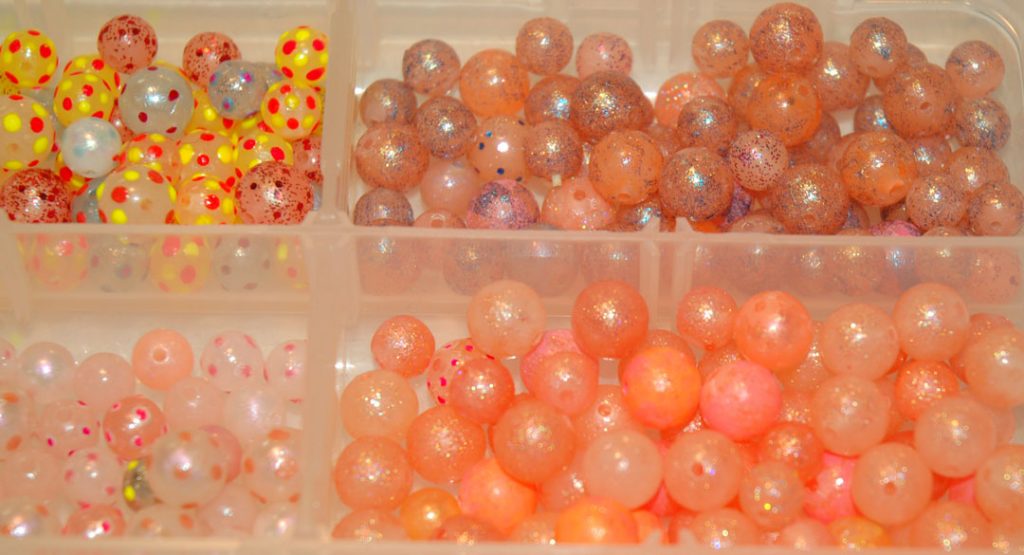
Small, hard-plastic trout beads are another excellent presentation. While they lack the natural scent of egg sacs, their realistic appearance is often enough to fool a steelhead. These beads are available in an infinite array of colors, and serious steelheaders further customize them with nail polish. The natural egg colors of orange and peach are a good place to start, with many guides agreeing that muted, milky colors are a better match to the dead salmon eggs steelhead are likely to encounter in the river this time of year.
Small hair jigs fished under a float can be very effective, especially when tipped with waxworms for added scent.
Fly fishermen have endless options for egg-imitating flies, and they also fare well with stonefly imitations, sucker spawn, caddis pupa, San Juan worms, and even plain old Woolly Buggers. With the egg imitations, muted colors are best this time of year.
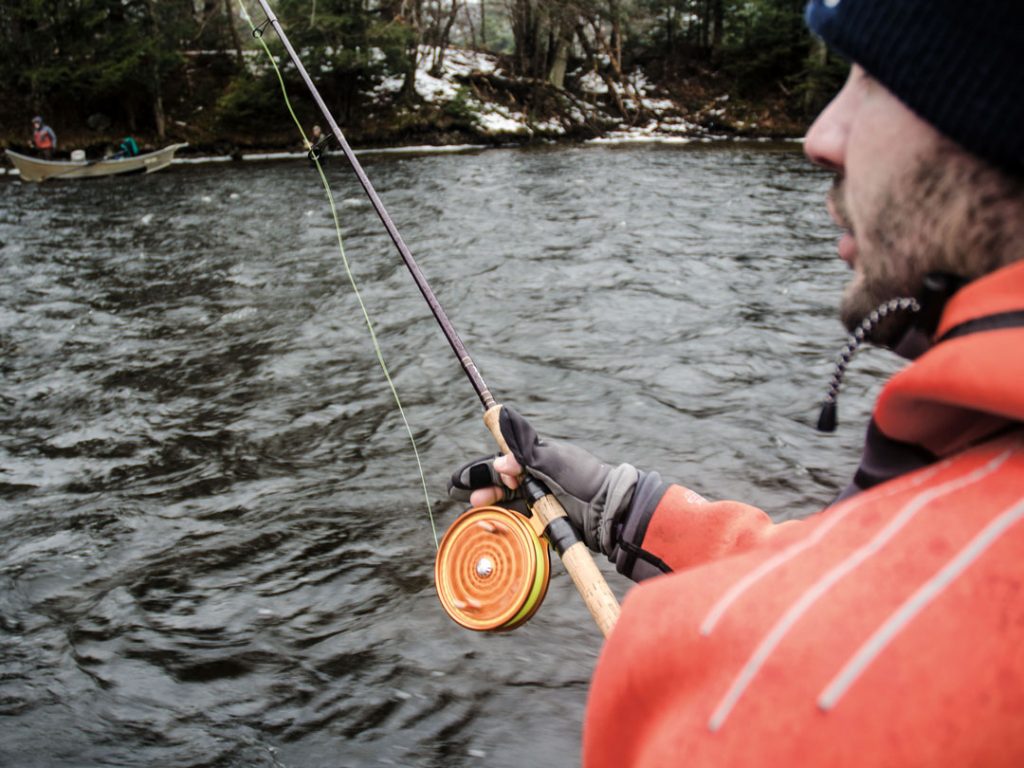
Light leader can also help when fooling winter steelhead. Even though these fish grow in excess of 10 pounds and fight like banshees, anglers regularly drop to 4-pound test in order to get bites during cold, clear, heavy-fishing-pressure conditions.
Dressing for Winter Steelheading
It gets cold on the Salmon River, so dressing appropriately for the weather will help ensure you’re on the river rather than warming up in the car when the steelhead turn on.
Hands and feet are the most vulnerable to the cold. Feet should be ensconced in thermal socks that are not so thick as to impede circulation when inside waders and boots. Fold-over mitts with open fingers are the best option for keeping hands warm without sacrificing dexterity for casting, tying knots, or feeling bites.
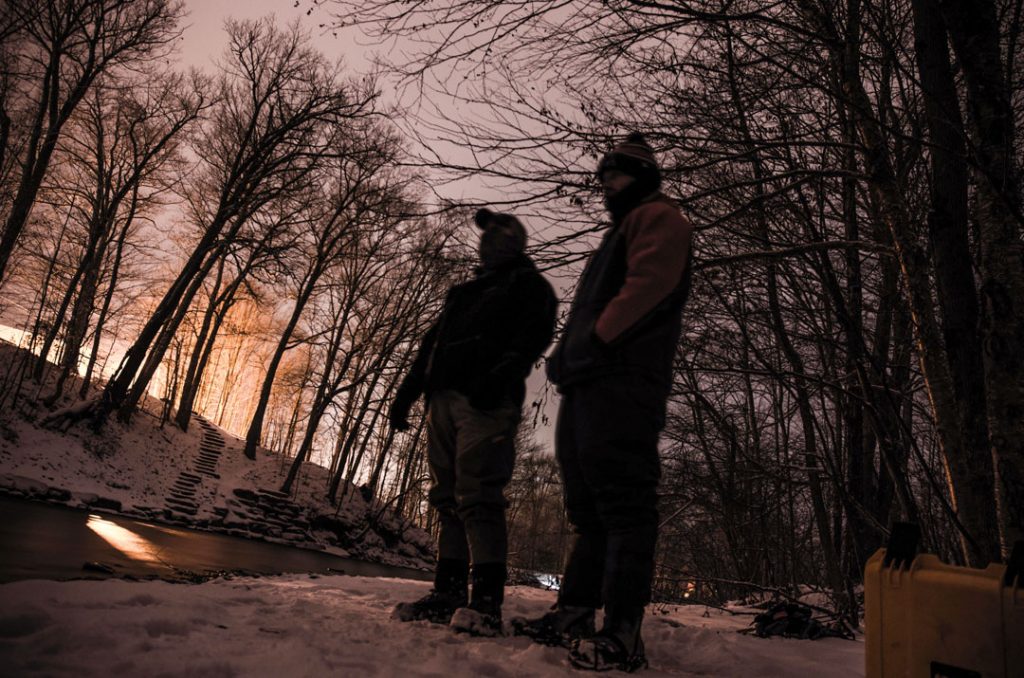
While neoprene waders are considered a warmer option by some anglers, layers under a pair of breathable waders is a more comfortable option. Layer up with long johns, a thick flannel, and a jacket that will cut the windchill. Don’t forget a winter hat because (as everyone’s mom warned them when growing up) heat escapes through your head.
Regardless of season, anglers on the Salmon River need studded soles to safely navigate the slick river rocks. However, be sure to remove them before going inside anywhere. Every Salmon River establishment, from bait shops to McDonalds, have signs warning anglers against wearing their cleats indoors.
Planning a Salmon River Road Trip
Unlike most of our Northeast fishing destinations, winter is in the heart of the Salmon River’s fishing season, so you’ll find tackle shops, lodges, and guide services fully operational. The first shop you’ll encounter when entering Pulaski is the truck stop/tackle shop Fat Nancy’s, where you’ll find all the tackle needed for bottom bouncing. A bit down the road is All Seasons Sports, where they carry everything necessary to successfully float-fish for steelhead. Whitaker’s is just beyond that and is a must-stop for the fly fisher; same with Malinda’s further down in Altmar. Between Whitaker’s and Malinda’s is Pineville Sports, the home of the regionally famous “Blue Goo” egg sac, which is coated in a fish-attracting scent that doesn’t wash out as quickly as other eggs.
There are a similar variety of guides available to accommodate all fishing levels and styles, from shore-bound guides to those with drift boats. In the winter, a drift boat ride feels especially luxurious, with propane heaters on board and no wading necessary.
Fishermen can find a wide range of lodging options to accommodate different budgets and preferences from inexpensive, hostel-style bunk rentals to the high-end, riverside fishing lodges.
SHOPS
3 Pulaski St, Altmar, NY
(315) 298-2993
malindasflyshop.business.site
4826 Salina St, Pulaski, NY
(315) 592-1556
Salmon River Sports Shop on Facebook
LODGING
2358 County Rte 22, Altmar, NY
(315) 298-2993
headwaterscabins.com
GUIDES
800 County Rte 5, Pulaski, NY
(860) 982-8392
joesoutdoorandfishingadventures.com
2 on “Winter Steelhead Fishing On the Salmon River”
-
Nick Telesky Great article but you overlooked including the best steelhead and salmon guide on the Salmon River. Eric Geary of SWAT Fishing is by far superior. We have fished with other drift boat and river side guides and Eric Geary is by far the best. Puts folks in fish when other cannot.
-
Jay Fritz Everyone has their favorite guide service. The rating process is like comparing any match making business. It’s a personal choice involving personalities, number and success record of outing experiences under varying conditions, like weather and water levels.
I was fortunate enough to live in CNY for 60 years and until last last year was able yearly to
steelhead at least a dozen times each winter. When it became prudent to retire my waders, I signed up with different drift guides. Then for 20 years, I would only enlist with STS Guide Service and Chasin Tail Adventures. Interesting, they were the same guides that On the Water chose to feature season 12, episode10, but were not mentioned in this article..
As an aside, I offer this tip. In the 90’s, the first appearance of drift boats on the Salmon River was not a welcome event for conventional waders. It signaled the start of an involuntary time out period until the boat passed from view. Not until I observed fish behavior from a drift boat that I understood that the boat energizes the fish it passes over. Moreover, they don’t shut down. Indeed, a drift boat likely ups the odds of a hookup for those fishing in the water.
Leave a Reply